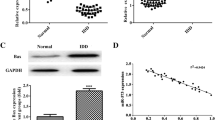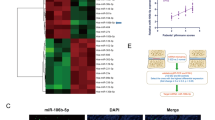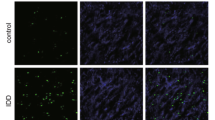Abstract
This study aimed to investigate the molecular mechanism by which microRNA (miR)-96 regulates the progression of intervertebral disc degeneration (IDD). The expression of miR-96 in normal intervertebral discs and in IDD was detected by performing reverse transcription-quantitative PCR. CCK8 assay was applied to examine the proliferation of nucleus pulpous (NP) cells and flow cytometry was used to evaluate the cell apoptosis and cell cycle profile. In addition, the immunofluorescence analysis was employed to detect cell proliferation. The expressions of proteins were assessed by western blot analysis. TargetScan and miRDB were used to predict the target genes of miR-96. The results indicated that miR-96 expression was upregulated in IDD compared with normal intervertebral discs. Overexpression of miR-96 could significantly inhibit the proliferation of NP cells via inducing apoptosis and G1 arrest. In addition, fibroblast growth factor receptor substrate 2 (FRS2) was identified as the target of miR-96 and overexpression of FRS2 could revere the effect of miR-96 mimics in NP cells. Therefore, these findings demonstrated that miR-96 plays a critical role during the progression of IDD and miR-96 may serve as a target for the treatment of IDD.







Similar content being viewed by others
Change history
08 September 2020
In the original publication of the
References
Dagenais S, Caro J, Haldeman S. A systematic review of low back pain cost of illness studies in the United States and internationally. Spine J. 2008;8:8–20.
Manchikanti L, Singh V, Falco FJ, Benyamin RM, Hirsch JA. Epidemiology of low back pain in adults. Neuromodulation. 2014;17(Suppl 2):3–10.
Miller JA, Schmatz C, Schultz AB. Lumbar disc degeneration: correlation with age, sex, and spine level in 600 autopsy specimens. Spine Phila Pa. 1988;13:173–8.
Roberts S, Evans H, Trivedi J, Menage J. Histology and pathology of the human intervertebral disc. J Bone Joint Surg Am. 2006;88(Suppl 2):10–4.
Vergroesen PP, Kingma I, Emanuel KS, Hoogendoorn RJ, Welting TJ, van Royen BJ, et al. Mechanics and biology in intervertebral disc degeneration: a vicious circle. Osteoarthritis Cartilage. 2015;23:1057–70.
Pillai RS. MicroRNA function: multiple mechanisms for a tiny RNA? RNA. 2005;11:1753–61.
Haseeb A, Makki MS, Khan NM, Ahmad I, Haqqi TM. Deep sequencing and analyses of miRNAs, isomiRs and miRNA induced silencing complex (miRISC)-associated miRNome in primary human chondrocytes. Sci Rep. 2017;7:15178.
Li F, Huang J, Liu J, Xu W, Yuan Z. Multivariate analysis of clinicopathological and prognostic significance of miRNA 106b–25 cluster in gastric cancer. Cancer Cell Int. 2019;19:200.
Berindan-Neagoe I, Monroig Pdel C, Pasculli B, Calin GA. MicroRNAome genome: a treasure for cancer diagnosis and therapy. CA Cancer J Clin. 2014;64:311–36.
Parrella P, Barbano R, Pasculli B, Fontana A, Copetti M, Valori VM, et al. Evaluation of microRNA-10b prognostic significance in a prospective cohort of breast cancer patients. Mol Cancer. 2014;13:142.
Chai X, Si H, Song J, Chong Y, Wang J, Zhao G. miR-486-5p inhibits inflammatory response, matrix degradation and apoptosis of nucleus pulposus cells through directly targeting foxo1 in intervertebral disc degeneration. Cell Physiol Biochem. 2019;52:109–18.
Wang J, Liu X, Sun B, Du W, Zheng Y, Sun Y. Upregulated miR-154 promotes ECM degradation in intervertebral disc degeneration. J Cell Biochem. 2019;1:23.
He PY, Yip WK, Jabar MF, Mohtarrudin N, Dusa NM, Seow HF. Effect of the miR-96-5p inhibitor and mimic on the migration and invasion of the SW480-7 colorectal cancer cell line. Oncol Lett. 2019;18:1949–60.
Dong XZ, Song Y, Lu YP, Hu Y, Liu P, Zhang L. Sanguinarine inhibits the proliferation of BGC-823 gastric cancer cells via regulating miR-96–5p/miR-29c-3p and the MAPK/JNK signaling pathway. J Nat Med. 2019;20:10.
Shao S, Wang C, Wang S, Zhang H, Zhang Y. LncRNA STXBP5-AS1 suppressed cervical cancer progression via targeting miR-96-5p/PTEN axis. Biomed Pharmacother. 2019;117:109082.
Dudics S, Venkatesha SH, Moudgil KD. The micro-rna expression profiles of autoimmune arthritis reveal novel biomarkers of the disease and therapeutic response. Int J Mol Sci. 2018;19:12.
Xie W, Sun F, Chen L, Cao X. miR-96 promotes breast cancer metastasis by suppressing MTSS1. Oncol Lett. 2018;15:3464–71.
Hong Y, Liang H, Uzair Ur R, Wang Y, Zhang W, Zhou Y, et al. miR-96 promotes cell proliferation, migration and invasion by targeting PTPN9 in breast cancer. Sci Rep. 2016;6:37421.
Liu H, Liu Q, Wu XP, He HB, Fu L. MiR-96 regulates bone metabolism by targeting osterix. Clin Exp Pharmacol Physiol. 2018;45:602–13.
Anderson DG, Tannoury C. Molecular pathogenic factors in symptomatic disc degeneration. Spine J. 2005;5:260S–S266266.
Ding F, Shao ZW, Xiong LM. Cell death in intervertebral disc degeneration. Apoptosis. 2013;18:777–85.
Agarwal M, Sharma A, Kumar P, Kumar A, Bharadwaj A, Saini M, et al. Myosin heavy chain-embryonic regulates skeletal muscle differentiation during mammalian development. Development. 2020;12:46.
Tambalo M, Mitter R, Wilkinson DG. A single cell transcriptome atlas of the developing zebrafish hindbrain. Development. 2020;9(2):1.
Furusho M, Ishii A, Hebert JM, Bansal R. Developmental stage-specific role of Frs adapters as mediators of FGF receptor signaling in the oligodendrocyte lineage cells. Glia. 2020;68:617–30.
Chen J, Cui X, Li L, Qu J, Raj JU, Gou D. MiR-339 inhibits proliferation of pulmonary artery smooth muscle cell by targeting FGF signaling. Physiol Rep. 2017;5:2.
Lu TY, Lin B, Li Y, Arora A, Han L, Cui C, et al. Overexpression of microRNA-1 promotes cardiomyocyte commitment from human cardiovascular progenitors via suppressing WNT and FGF signaling pathways. J Mol Cell Cardiol. 2013;63:146–54.
Desjarlais M, Wirth M, Rivera JC, Lahaie I, Dabouz R, Omri S, et al. MicroRNA-96 Promotes vascular repair in oxygen-induced retinopathy-a novel uncovered vasoprotective function. Front Pharmacol. 2020;11:13.
Chew NJ, Nguyen EV, Su SP, Novy K, Chan HC, Nguyen LK, et al. FGFR3 signaling and function in triple negative breast cancer. Cell Commun Signal. 2020;18:13.
Li H, Mao Y, Bouaziz M, Yu H, Qu X, Wang F, et al. Lens differentiation is controlled by the balance between PDGF and FGF signaling. PLoS Biol. 2019;17:e3000133.
Kohlmeyer JL, Kaemmer CA, Pulliam C, Maharjan CK, Moreno Samayoa A, Major HJ, et al. RABL6A is an essential driver of MPNSTs that negatively regulates the RB1 pathway and sensitizes tumor cells to CDK4/6 inhibitors. Clin Cancer Res. 2020;12(3):57–87.
Shi X, Zhu K, Ye Z, Yue J. VCP/p97 targets the nuclear export and degradation of p27(Kip1) during G1 to S phase transition. FASEB J. 2020;1:2.
Xie C, Shen X, Xu X, Liu H, Li F, Lu S, et al. Astrocytic YAP promotes the formation of glia scars and neural regeneration after spinal cord injury. J Neurosci. 2020;23:6.
Fouani L, Huang MLH, Cole L, Jansson PJ, Kovacevic Z, Richardson DR. During mitosis ZEB1 switches from being a chromatin-bound epithelial gene repressor, to become a microtubule-associated protein. Biochim Biophys Acta Mol Cell Res. 2020;11(8):6–73.
Liu JL, Ma HP, Lu XL, Sun SH, Guo X, Li FC. NF-kappaB induces abnormal centrosome amplification by upregulation of CDK2 in laryngeal squamous cell cancer. Int J Oncol. 2011;39:915–24.
Su L, Yao Y, Song W. Downregulation of miR-96 suppresses the profibrogenic functions of cardiac fibroblasts induced by angiotensin II and attenuates atrial fibrosis by upregulating KLF13. Hum Cell. 2020;4(3):1.
Funding
This study was funded by National Natural Science Foundation of China (81802190, 81772412), Shandong Medical and Health Technology Development Plan Project (2017WS033) and Youth Fund Project of the Affiliated Hospital of Qingdao University (2017).
Author information
Authors and Affiliations
Corresponding author
Ethics declarations
Conflict of interest
These authors declared no competing interests.
Ethical approval
All of the experiments were approved by the Ethics Committees of the Affiliated Hospital of Qingdao University (No. 2015006688). The informed consent forms were signed by patients or their families.
Additional information
Publisher's Note
Springer Nature remains neutral with regard to jurisdictional claims in published maps and institutional affiliations.
Rights and permissions
About this article
Cite this article
Yang, X., Liu, H., Zhang, Q. et al. MiR-96 promotes apoptosis of nucleus pulpous cells by targeting FRS2. Human Cell 33, 1017–1025 (2020). https://doi.org/10.1007/s13577-020-00389-9
Received:
Accepted:
Published:
Issue Date:
DOI: https://doi.org/10.1007/s13577-020-00389-9




